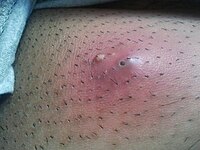
Photo from wikipedia
Purpose of review To summarize the recent literature on the topic of residual stone fragments in particular novel developments in this field. Recent findings The urological position towards residual fragments… Click to show full abstract
Purpose of review To summarize the recent literature on the topic of residual stone fragments in particular novel developments in this field. Recent findings The urological position towards residual fragments has shifted in recent years from observation, to active retrieval with innovative methods, to algorithm-based predictions of surgical outcomes. Novel technologies have been described to extract residual fragments through magnetism, a polyethylene endoscopic pouch and a biocompatible stone adhesive. In an effort to have a tighter grip over the outcome of residual fragments, artificial neural networks (ANNs) have been developed to accurately predict surgical outcomes in terms of stone clearance and secondary procedures. Summary Growing evidence continues to show the term clinically insignificant residual fragments (CIRF) for residual fragments of 4 mm or less to be a misnomer. In fact, only a third of CIRF is spontaneously cleared from the kidney after surgery and may become a cause for reintervention being both costly and significantly affecting patients’ well being. Several novel methods which have been developed to extract residual fragments require further in-vivo investigations to confirm their safety and efficacy. ANNs algorithms are increasingly being used to predict surgical outcomes in stone therapy and assist in preoperative patient counselling and decision-making.
Journal Title: Current Opinion in Urology
Year Published: 2019
Link to full text (if available)
Share on Social Media: Sign Up to like & get
recommendations!